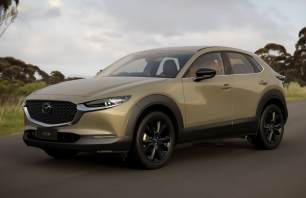It’s rare in 2024 to find a small SUV that doesn’t have at least one turbocharger attached to its engine, the CX-30’s 2.5-litre ‘atmo’ four being one of those increasingly scarce examples.
But Mazda’s been laser-focused on extracting maximum power and efficiency from its non-turbo petrol engines for yonks and this one stands up well.
It doesn’t have the low-down punch a turbo typically delivers but maximum pulling power arrives at a useable 4000rpm and it’s eager enough for easy city and suburban running as well as confident freeway cruising.
Although Mazda doesn’t quote an official number you can expect a sprint from 0-100km/h in around 8.5 seconds, which is quick for the class.
Worth noting engine noise and a raspy exhaust note make their presence felt under acceleration and the throttle isn’t as refined as it could be. Not a huge deal, but a slight jerkiness is evident on initial, especially moderate, acceleration.
The six-speed auto is smooth and fuss-free, the steering wheel paddle shifters on hand if you need to intervene and select a specific ratio. ‘Sport’ mode peps things up, causing the transmission to shift down earlier and up later. But it’s aggressive in that it often holds onto a gear for too long and you find yourself diving back to the default normal setting.
Tipping the scales at just under 1.5 tonnes, the CX-30 is underpinned by a MacPherson strut front, torsion beam rear suspension and ride comfort on typically pock-marked urban surfaces is average for the category. That is, a bit jittery over bumps and corrugations but there’s no bone-jarring going on here.
Steering feel and response is good and the grippy steering wheel helps with a connection to the front tyres. Speaking of which, the standard rubber is high-performance (215/55) Dunlop SP Sport Maxx 050 which is grippy and commendably quiet.
Push on into a corner and the CX-30 remains balanced and predictable with body roll well under control. Torque vectoring, by engine and physical braking, is also onboard to reel things in if you overstep the mark.
Braking is by discs all around, vented at the front and solid at the rear, and they wash off speed effectively with a satisfyingly progressive pedal action.
Vision is good, which combined with the CX-30’s compact dimensions and 10.6m turning circle, means parking is easy. Especially when you factor in the hi-res reversing camera and front and rear parking sensors.

